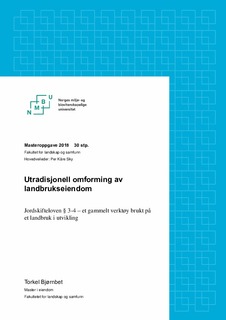| dc.contributor.advisor | Sky, Per Kåre | |
| dc.contributor.author | Bjørnbet, Torkel | |
| dc.coverage.spatial | Norway | nb_NO |
| dc.date.accessioned | 2018-11-06T15:09:53Z | |
| dc.date.available | 2018-11-06T15:09:53Z | |
| dc.date.issued | 2018 | |
| dc.identifier.uri | http://hdl.handle.net/11250/2571303 | |
| dc.description.abstract | Denne masteroppgaven tar for seg det jeg har valgt å omtale som utradisjonell omforming av landbrukseiendom ved jordskifte. Med utradisjonell omforming har jeg forutsatt et jordskifte der eiendomsobjektene som skiftes fremstår som svært ulike og at en eller flere av eiendommene endrer karakter ved skiftet.
Problemstillingen i oppgaven består av en hovedproblemstilling:
Hva begrenser muligheten for utradisjonell omforming av landbrukseiendom med hjemmel i jordskifteloven § 3-4?
Samt to delproblemstillinger:
1. Hvilke begrensninger er det i lov?
2. Hvordan forholder jordskiftedommere seg til utradisjonelle bytter?
Delproblemstilling 1 er hovedsakelig basert på juridisk metode, med analyse av ulike rettskilder, først og fremst gjeldende jordskiftelov og dens forarbeider.
Delproblemstilling 2 bygger på en kvalitativ undersøkelse som har bestått i en intervjuundersøkelse der et utvalg på 13 jordskiftedommere har blitt intervjuet.
Hovedproblemstillingen er forsøkt besvart gjennom en helhetlig drøfting av teori (delproblemstilling 1) og empiri (delproblemstilling 2).
Av interessante funn i oppgaven nevnes følgende:
• En viktig begrensende faktor for slike omforminger vil være at en eiendom ikke må skifte karakter i for stor grad, jf. jordskifteloven § 3-18.
• Flertallet av jordskiftedommerne i undersøkelsen synes å være villig til å godta utradisjonelle skifter i større utstrekning enn det jordskifteloven legger opp til. | nb_NO |
| dc.description.abstract | This master thesis examines what I define as unconventional, agricultural arrangements through land consolidation. The prerequisite for this definition, is that the land consolidation consists of a property exchange where the result changes the output of one or more of the involved properties.
The main question is:
What limits the potential for unconventional use of the Land Consolidation Act § 3-4?
I have two sub-questions:
1. What limits are there within the law?
2. What thoughts do the land consolidation judges have in relation to this matter?
Sub-question 1 is mainly based on legal method, with an analysis of various legal sources, mainly the Land Consolidation Act and its preparatory work.
Sub-question 2 builds upon material gathered through a qualitative survey, in the form of an in-depth interview of 13 land consolidation judges.
My primary findings are as follows:
• A considerable limitation is the Land Consolidation Act’s reluctance to allow agricultural property to risk losing its industrial output by giving away agricultural land.
• Most of the land consolidation judges in the survey seemed to be willing to go beyond the apparent limitations of the Land Consolidation Act, in instances where the owners of the properties had an agreement, and were willing to risk their agricultural output. | nb_NO |
| dc.language.iso | nob | nb_NO |
| dc.publisher | Norwegian University of Life Sciences, Ås | nb_NO |
| dc.rights | Attribution-NonCommercial-NoDerivatives 4.0 Internasjonal | * |
| dc.rights.uri | http://creativecommons.org/licenses/by-nc-nd/4.0/deed.no | * |
| dc.title | Utradisjonell omforming av landbrukseiendom : Jordskifteloven § 3-4 : et gammelt verktøy brukt på et landbruk i utvikling | nb_NO |
| dc.type | Master thesis | nb_NO |
| dc.description.localcode | M-EIE | nb_NO |

